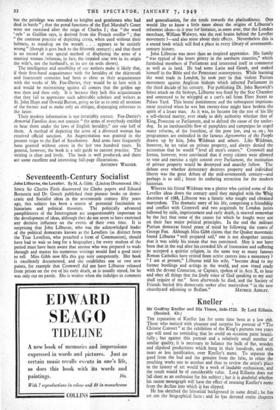Heraldry
Intelligible Heraldry. By Sir Christopher Lynch-Robinson and Adrian Lynch-Robinson, with a Foreword by the Chief Herald of Ireland, Edward MacLysaght. (Macdonald. 18s.) IT is not surprising that eight centuries of growth in a changing environment have developed in the language and practice of heraldry complications which alarm the novice. To-make them intelligible by careful selection of essentials, and explanation of what seems irrational, is a praiseworthy undertaking. There are two ways of setting about it. The historical method treats as essential those features which carne first, and selects from among the later elabora- tions partly on technical merits but as much or more upon historical persistence. This is not the method of the present authors, who write of " the antiquarian approach " in _a pejorative sense. Theirs is the second method, which takes present and recent practice and tries to simplify and explain it upon principles of logic and common sense with little or no reference to origins.
The advantage of this approach is that which radicals often have over conservatives, that, unhampered by historical consciousness of )vhy things are what they are, they can more easily make innovations. And it should be said at once that on practical heraldic problems of taste and method our authors have some good and judicious things to say, and say them with clarity and wit. The " armorial authorities," to whom they refer with deference, should take their suggestions seriously. There is face, too, in their contention that Elizabethan inventions by Gerard Legh and others, which have established their vitality in modern practice, ought not now to be damned as "nonsense language brewed in the post-mediaeval period." Certainly the modern as well' as the mediaeval centuries have given good things to heraldry. But the argument would carry more conviction if it did not appear that the authors were seeking to make a virtue of their ignorance of heraldic history and in particular of the heraldry of the golden age.
This they betray both by mistakes and by omissions. They believe that, " up to and during the Plantagenet period, no more than four quarters were ever placed upon a shield " ; that " the exclusive jurisdiction of deciding officially rights to arms and claims of descent was bestowed upon the heralds by Edward III " ; that " only kings, princes and peers were entitled to be represented on their tombs by effigies clad m full armour displaying their full heraldic achievements,
but the privilege was extended to knights and gentlemen who had died in battle " ; that the penal functions of the Earl Marshal's Court were not exercised after the reign of Charles I ; that " the word 'ork ' as Guillim says, is derived from the French oreiller " ; that " the common practice of depicting crests, when used without their helmets, as standing on the wreath . . . appears to be entirely wrong " (though it goes back to the fifteenth century) ; and that there is no record of any special method of displaying the arms of a married woman (whereas, in fact, the impaled coat was in its origin the wife's, not the husband's, as its use on seals shows).
The intelligence and sensibility of our authors make it likely that, if their first-hand acquaintance with the heraldry of the thirteenth and fourteenth centuries had been as close as their acquaintance with the works of Mr. Fox-Davies, they would be in love with it and would be maintaining against all comers that the golden age was then and then only. It is because they lack this acquaintance that they fail to appreciate such admirable scholars and writers as St. John Hope and Oswald Barron, going so far as to omit all mention of the former and to make only an oblique, disparaging reference to the latter.
Their modern information is not invariably correct. Fox-Davies's Armorial Families does not contain " the arms of everybody entitled to bear them under the laws of English heraldry," nor one half of them. A method of depicting the arms of a divorced woman has received official sanction. An Augmentation was granted in the present reign to the Earl of Strathmore. And arms have frequently been granted without crests in the last two hundred years. In general, however, the book is a safe guide to current practice. The writing is clear and lively. The book is well produced, and there are some excellent and interesting full-page illustrations.
ANTHONY WAGNER.







































 Previous page
Previous page